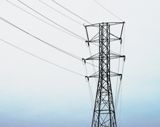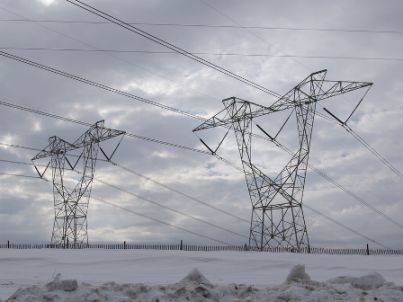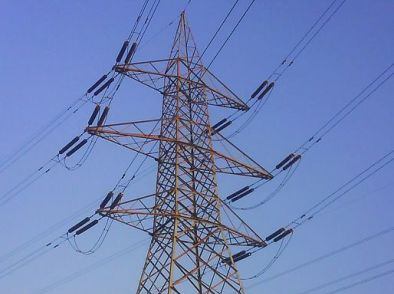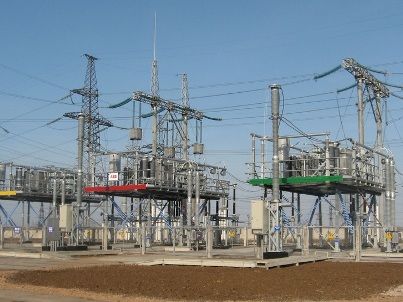Measures to improve the stability and continuous operation of power lines over long distances
 The stability of the parallel operation of the power line plays the most important role in the transmission of electrical energy over long distances. According to the stability conditions, the transmission capacity of the line increases in proportion to the square of the voltage, and therefore increasing the transmission voltage is one of the most effective ways to increase the load on a circuit and thus reduce the number of parallel circuits.
The stability of the parallel operation of the power line plays the most important role in the transmission of electrical energy over long distances. According to the stability conditions, the transmission capacity of the line increases in proportion to the square of the voltage, and therefore increasing the transmission voltage is one of the most effective ways to increase the load on a circuit and thus reduce the number of parallel circuits.
In cases where it is technically and economically impractical to transmit very large powers of the order of 1 million kW or more over long distances, then a very significant increase in voltage is required. At the same time, however, the size of the equipment, its weight and cost, as well as the difficulties in its production and development, increase significantly. In this regard, measures have been developed in recent years to increase the capacity of transmission lines, which would be cheap and at the same time quite effective.
From the point of view of power transmission reliability, it matters how static and dynamic stability of parallel operation... Some of the activities discussed below are relevant to both types of stability, while others are primarily for one of them, which will be discussed in -down.
Speed off speed
The generally accepted and cheapest way to increase the transmitted power is to reduce the time to turn off the damaged element (line, its separate section, transformer, etc.), which consists of the action time relay protection and the operating time of the switch itself. This measure is widely applied to existing power lines. In terms of speed, many great advances have been made in recent years in both relay protection and circuit breakers.
The stopping speed is important only for dynamic stability and mainly for interconnected transmission lines in case of faults on the transmission line itself. For block transmissions of energy, where a fault on the line leads to the shutdown of the block, dynamic stability is important in case of faults in the receiving (secondary) network and therefore it is necessary to take care of the fastest removal of the fault in this network.

Application of high speed voltage regulators
In the case of short circuits in the network, due to the flow of large currents, there is always one or the other reduction in voltage. Voltage dips can also occur for other reasons, for example, when the load increases rapidly or when the generator power is turned off, resulting in power being redistributed between individual stations.
A decrease in voltage leads to a sharp deterioration in the stability of parallel operation... To eliminate this, a rapid increase in the voltage at the ends of the power transmission is required, which is achieved by using high-speed voltage regulators that affect the excitation of the generators and increase their tension.
This activity is one of the cheapest and most effective. However, it is necessary that the voltage regulators have inertia, and in addition, the excitation system of the machine must provide the necessary rate of rise of the voltage and its magnitude (multiplicity) compared to normal, i.e. the so-called ceiling ".
Improvement of hardware parameters
As mentioned above, the total value transmission resistance includes the resistance of generators and transformers. From the point of view of the stability of parallel operation, the important thing is the reactance (the active resistance, as mentioned above, affects the power and energy loss).
The voltage drop across the reactance of a generator or transformer at its rated current (current corresponding to the rated power), referred to the normal voltage and expressed as a percentage (or parts of a unit), is one of the important characteristics of a generator or transformer.
For technical and economic reasons, generators and transformers are designed and manufactured for specific responses that are optimal for a given type of machine. Reactances can vary within certain limits, and a decrease in reactance is, as a rule, accompanied by an increase in size and weight, and therefore, in cost.However, the increase in the price of generators and transformers is relatively small and economically fully justified.
Some of the existing transmission lines use equipment with improved parameters. It should also be noted that in practice, in some cases, equipment with standard (typical) reactants is used, but with a slightly higher power, calculated in particular for a power factor of 0.8, while in fact according to the transmission mode of power , should be expected to be equal to 0. 9 — 0.95.
In cases where the power is transmitted from the hydroelectric station and the turbine can develop a power greater than the nominal one by 10%, and sometimes even more, then at pressures exceeding the calculated one, an increase in the active power given by the generator is possible.
Change of posts
In the event of an accident, one of the two parallel lines operating in a connected scheme and without intermediate selection, it completely breaks down and therefore the resistance of the power line is doubled. Transmission of twice as much power on the remaining working line is possible if it has a relatively short length.
For lines of considerable length, special measures are taken to compensate for the voltage drop in the line and to keep it constant at the receiving end of the power transmission. To that end, powerful synchronous compensatorswhich send reactive power to the line that partially compensates for the lagging reactive power caused by the reactance of the line itself and the transformers.
However, such synchronous compensators cannot guarantee the operation stability of long power transmission.On long lines, to avoid a reduction in the transmitted power in the event of an emergency shutdown of one circuit, switching poles can be used, which divide the line into several sections.
Busbars are arranged at the switching posts, to which separate sections of the lines are connected with the help of switches. In the presence of poles, in the event of an accident, only the damaged section is disconnected, and therefore the total resistance of the line increases slightly, for example, with 2 switching poles, it increases only by 30%, and not twice, as it would be with lack of switching posts.
In terms of the total resistance of the entire power transmission (including the resistance of generators and transformers), the increase in resistance will be even less.

Separation of wires
The reactance of a conductor depends on the ratio of the distance between the conductors to the radius of the conductor. As the voltage increases, as a rule, the distance between the wires and their cross-section, and therefore the radius, also increases. Therefore, the reactance varies within relatively narrow limits, and in approximate calculations it is usually taken equal to x = 0.4 ohms / km.
In the case of lines with a voltage of 220 kV and more, the so-called phenomenon is observed. "Crown". This phenomenon is associated with energy losses, especially significant in bad weather. In order to eliminate excessive corona losses, a certain diameter of the conductor is required. At voltages above 220 kV, dense conductors with such a large cross-section are obtained that it cannot be economically justified.For these reasons, hollow copper wires have been proposed and have found some use.
From the point of view of the corona, it is more efficient to use instead of hollow - split wires... A split wire consists of 2 to 4 separate wires located at a certain distance from each other.
When the wire splits, its diameter increases and as a result:
a) energy losses due to the corona are significantly reduced,
b) its reactive and wave resistance decreases and, accordingly, the natural power of the power line increases. The natural power of the line increases approximately when splitting two strands by 25 — 30%, by three — up to 40%, by four — by 50%.
Longitudinal compensation
As the length of the line increases, its reactance increases accordingly, and as a result, the stability of parallel operation deteriorates significantly. Reducing the reactance of a long transmission line increases its carrying capacity. Such a reduction can most effectively be achieved by sequentially including static capacitors in the line.
Such capacitors in their effect are opposite to the action of the self-inductance of the line, and thus to one degree or another they compensate for it. Therefore, this method has the general name longitudinal compensation... Depending on the number and size of the static capacitors, the inductive resistance can be compensated for one or another length of line. The ratio of the length of the compensated line to its total length, expressed in parts of a unit or as a percentage, is called the degree of compensation.
Static capacitors included in the transmission line section are exposed to unusual conditions that can occur during a short circuit both on the transmission line itself and outside it, for example in the receiving network. The most serious are short circuits on the line itself.
When large emergency currents pass through the capacitors, the voltage in them increases significantly, albeit for a short time, but it can be dangerous for their insulation. To avoid this, an air gap is connected in parallel with the capacitors. When the voltage across the capacitors exceeds a certain, preselected value, the gap is cut and this creates a parallel path for the emergency current to flow. The whole process takes place very quickly and after its completion the efficiency of the capacitors is restored again.
When the degree of compensation does not exceed 50%, then the most suitable installation is static capacitor banks in the middle of the line, while their power is somewhat reduced and the working conditions are made easier.

